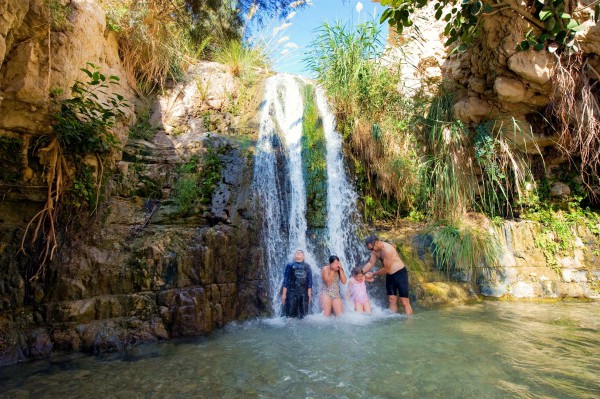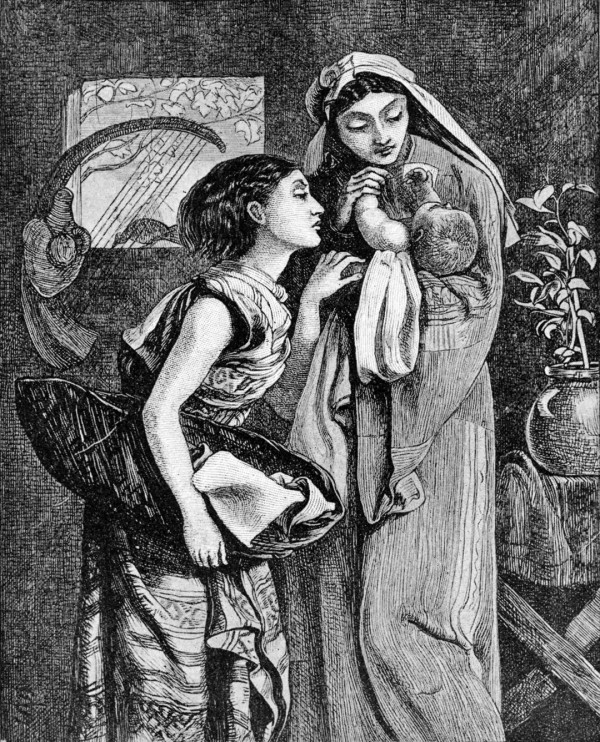Chukat (Statute or Decree)
Numbers 19:1–22:1; Judges 11:1–33; Hebrews 9:1–28
“This is a requirement [חֻקַּ֣ת / Chukat / statute] of the law [Torah] that the LORD has commanded: Tell the Israelites to bring you a red heifer [parah adumah].” (Numbers 19:2)
Last week in Parasha Korach, the Levite Korach incited mutiny against Moses. He and 250 chieftains of Israel questioned the anointed position of Moses as leader and Aaron as high priest.
This week’s Torah portion, called Parasha Chukat, presents the ritual laws of the Parah Adumah (פָרָה אֲדֻמָּה / Red Heifer) and the deaths of Aaron and the prophetess Miriam, Moses, and Aaron’s sister.
The Bridge from Impurity to Purity
To purify the Temple vessels and priest, the chosen red heifer (a young female cow that has not yet borne a calf) was to be blemish and defect free. It also must never have borne a yoke.
It would be slaughtered under the supervision of the Jewish Priest (Cohen), who would then sprinkle its blood seven times toward the Tabernacle. Its body would be burned outside the camp and its ashes used to create the waters of purification.
The waters of purification are necessary to ritually cleanse those who had been contaminated by death through contact with a corpse, bone, or grave. Once purified, they could enter the Tabernacle to draw near to the Living God.
In Hebrew, the concepts of clean and unclean or pure (tahor) and impure (tamei) are akin to an insider and an outsider. Only those who were tahor (clean / pure) could enter the dwelling place of God’s presence.
Those who were deemed tamei (unclean / defiled) would be kept outside and, if not purified, would be cut off from Israel — for example, lepers.
Along with the ashes of the Parah Adumah being added to the waters of purification, three other elements were put in: hyssop, cedar wood, and scarlet thread.
These elements were all used in the building of the sanctuary. The hyssop was used by the priests for sprinkling the blood, the cedar wood was used for the posts, and the scarlet thread was used in the curtains.
Though this mysterious mixing — the sacred elements combined with the ashes of the heifer — death and life would come together in order to bring forth cleansing and purification, which would allow a person to cross the bridge from tamei to tahor.
The Brit Chadashah (New Testament) also speaks of the ashes of the Parah Adumah, promising that the blood of the Messiah has greater power to cleanse our conscience from dead works to serve the Living God:
“For if the blood of bulls and goats and the ashes of a heifer, sprinkling the unclean, sanctifies for the purifying of the flesh, how much more shall the blood of Messiah, who through the eternal Spirit offered Himself without spot to God, cleanse your conscience from dead works to serve the Living God?” (Hebrews 9:13–14)

A father and his children refresh themselves at the Ein Gedi oasis, which is near Masada and the Dead Sea.
Miriam Perishes in the Wilderness
“Then the children of Israel, the whole congregation, came into the Wilderness of Zin in the first month, and the people stayed in Kadesh; and Miriam died there and was buried there.” (Numbers 20:1)
Besides the symbolism of life and death in the waters of purification, this week’s Parasha also provides some details of the death of Moses and Aaron’s sister, Miriam, in the Wilderness of Zin.
Her death occurs about one year before the Israelites enter the Promised Land, and it is also connected to water.
The last time we read about Miriam, she had been stricken with tzara’at (leprosy) as a punishment for speaking against Moses’ choice of a Cushite (Ethiopian) wife.
The tzara’at caused her to become tamei (defiled / impure), and she was exiled from the camp for the required period of seven days after “Moses cried out to the LORD, ‘Please, God, heal her!’” (Numbers 12:13)
Miriam lived many years after this, healed of her leprosy, and apparently never again allowed pride and arrogance to cause her to speak against the leadership of Moses.

Jocheved, Miriam, and Moses (illustration from the 1897 Bible Pictures and What They Teach Us by Charles Foster)
Miriam had played an important role in the prophetic fulfillment of God’s promise to bring Israel out of Egypt, and two of the biggest highlights involved water.
She was the one who carefully watched over baby Moses as he floated among the reeds of the Nile River in a basket. She bravely intervened and offered her mother’s services as a wet nurse when Pharaoh’s daughter rescued him.
Miriam led the procession of women singing, dancing, and rejoicing with tambourines after God safely led the Israelites through the waters of the Red Sea on dry land while drowning the pursuing Egyptians army.
Although Miriam was considered a leader and prophetess, her death is mentioned only briefly in the Scriptures. No mention is made of the usual mourning period. Rabbinic commentary suggests that Moses and Aaron buried her in the middle of the night (Yalkut Shimoni Mas’ei 787), and it seems that Moses and the people did not mourn her properly.
After Miriam’s death, the people thirsted for water and complained, yet again:
“Why did you bring us up out of Egypt to bring us to this terrible place, a seedless place without a fig or a vine or a pomegranate, without even water to drink?” (Numbers 20:5)
Since a vine can represent a mother at home with her children, like little shoots all around her table, some commentaries believe that the people who complained were mourning the loss of Miriam, who was like a mother to the Israelites, especially the women and children. If so, they were misdirecting their anguish. (Psalm 128:3)
The Well of Miriam
According to Jewish tradition, a water-bearing rock followed the Israelites in the wilderness, but dried up and disappeared at Miriam’s death. First Corinthians 10:1–4 is seen by some to confirm this rock:
“For I do not want you to be unaware, brethren, that our fathers were all under the cloud and all passed through the sea; and all were mikvahed [baptized] into Moses in the cloud and in the sea; and all ate the same spiritual food; and all drank the same spiritual drink, for they were drinking from a spiritual rock which followed them; and the rock was Messiah.”
This rock is called the Well of Miriam because the water that flowed from it was based on her merit. One Jewish Midrash fills in the gaps found in this tersely-written Bible account of her death with the following story:
“Miriam died, and the well was taken away so that Israel would recognize that it was through her merit that they had had the well. Moses and Aaron were weeping inside, and (the Children of) Israel were weeping outside, and for six hours Moses did not know (that the well was gone), until (the Children of) Israel entered and said to him: For how long will you sit and cry?
“He said to them: Should I not cry for my sister who has died? They said to him: While you are crying for one person, cry for all of us! He said to them: Why? They said to him: We have no water to drink. He got up from the ground and went out and saw the well without a drop of water (in it). He began to argue with them….” (Otzar Midrashim)
Whether a rock followed them, providing water, or Adonai gave them water wherever they went through other means, He did show mercy for their thirst, telling Moses to speak to the rock to bring forth water.
Nevertheless, before following through on God’s command to give them water, Moses responded in anger to their complaining, or perhaps anger at Adonai for Miriam’s death, saying, “Listen, you rebels, shall we get water for you out of this rock?” (Numbers 20:10)
There is a play on words in this verse. The Hebrew word for rebels (morim מרים) is spelled the same as the name Miriam (מרים) in Hebrew.
It seems that Moses is thinking of his sister Miriam and had not yet properly mourned. He may have misdirected his anger about her death toward the people.
In his anger or frustration, Moses struck the rock twice and water gushed out giving the people water to drink — but God had told Moses to speak to the rock, not to strike it.
Moses failed to model obedience at a time when all of Israel was looking to him for leadership. Therefore, the name of the water was called Meribah (which means to argue, strive or contend).
“Those were the waters of Meribah, because the sons of Israel contended with the LORD, and He proved Himself holy among them.” (Numbers 20:13)
This word, Meribah, can also be connected to Miriam. It can be read Meri-bah, which means Miri[yam] is in it — that is, Miriam is in the waters of contention.
Although Miriam’s name means bitterness, it can also be read Miri–yam (Miri of the sea). So, in yet another way, this “woman of the sea” is connected to the waters flowing out of the rock after her death.
Tending to Our Emotions
Although Moses never mentioned Miriam again after her death, and although she seemed to have been buried quickly, without great public ceremony, the memory of her has been irrepressible.
Like Moses’ anger that caused him to disobey God and strike the rock, whatever we repress instead of dealing with will ultimately demand attention. And it might be expressed in ways not pleasing to God. For instance, we must take the time to properly come to terms with our feelings of loss.
We must take the time to grieve, just as the people did at the end of this Torah reading for Aaron — six months after the death of Miriam.
Perhaps Moses did not take the time or did not have the luxury of that time because of his role as leader or because the people were thirsty.
Furthermore, it seems that Moses might not have brought his pain and disappointment to the Lord. In not doing so, he missed an opportunity to model his trust and faith in God’s love. Instead, he raged and disobeyed God.
If Moses cannot model faith during such times of loss, then it is only natural that many of us will suspect that we cannot. But we can and must.
We can bring to Him our deepest pain, our darkest despair, and our broken hearts. He will cleanse us spiritually from our contact with loss and death, and He will heal us.
May we likewise be healers, allowing rivers of living water to flow freely out of our inner being to help bring people back into a restored relationship with Adonai through the purification we experience in Yeshua HaMashiach (Jesus the Messiah).










